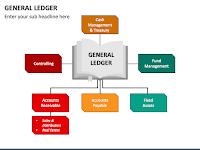The General Ledger (GL) is a core component of an ERP (Enterprise Resource Planning) system. It serves as the central repository for an organization's financial information, providing a comprehensive and consolidated view of its financial transactions. The General Ledger module plays a crucial role in financial accounting and reporting within the ERP system. Here are key aspects and functions of the General Ledger in ERP:
Financial Record Keeping:
The General Ledger records all financial transactions of an organization, including revenue, expenses, assets, liabilities, and equity. It maintains a detailed and organized record of each transaction.
Chart of Accounts : The General Ledger is structured based on a chart of accounts, which is a list of all the accounts used by an organization to classify and record its financial transactions. Each account in the chart of accounts represents a specific category of financial activity.
Double-Entry Accounting : The General Ledger follows the principles of double-entry accounting, ensuring that every transaction affects at least two accounts—debit and credit. This approach helps maintain the accounting equation (Assets = Liabilities + Equity) and ensures the accuracy of financial records.
Journal Entries : Journal entries, representing individual transactions, are posted to the General Ledger. Each entry includes details such as the date, accounts affected, amounts, and a brief description of the transaction.
Trial Balance : The General Ledger facilitates the creation of a trial balance, which is a summary of all the accounts and their balances at a specific point in time. The trial balance helps ensure that debits equal credits and serves as a preliminary step in the financial statement preparation process.
Financial Reporting : The General Ledger is instrumental in generating financial statements, such as the income statement, balance sheet, and cash flow statement. These reports provide a snapshot of the organization's financial health and performance.
Budgeting and Forecasting : The General Ledger module often integrates with budgeting and forecasting tools, allowing organizations to compare actual financial performance against planned budgets. This supports financial planning and analysis.
Closing Procedures : At the end of an accounting period, the General Ledger is involved in the closing process, where temporary accounts (such as revenue and expense accounts) are closed to the retained earnings account. This prepares the system for the next accounting period.
Audit Trail : The General Ledger maintains a comprehensive audit trail, recording the history of changes to financial data. This feature is essential for accountability, compliance, and internal or external audits.
Currency and Multi-Company Support : In global organizations or those with multiple entities, the General Ledger supports multi-currency transactions and consolidates financial information across different business units or subsidiaries.
The General Ledger module is interconnected with other ERP modules, such as Accounts Payable, Accounts Receivable, and Asset Management, ensuring seamless integration and accurate financial reporting across the organization.





0 Comments